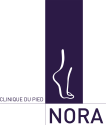
Little feet will grow big
When children reach the age of eight, their feet are already fully developed. Boys and girls therefore benefit from acquiring habits that will contribute to good overall motor skills as early as possible. At the onset of puberty, the body’s growth will amplify minor foot defects, often caused by poor posture or demanding physical activities.
A baby’s foot often appears chubby due to the amount of fatty tissue. Sometimes it is even difficult to determine its exact outline. This is normal and will gradually improve. A small foot that appears flat is nothing to worry about in early childhood. Between birth and age three, children go through several stages of motor development. At seven or eight months, they should be able to pull themselves up to a standing position; between 9 and 16 months, they should start walking. They will climb stairs between 16 and 18 months and be able to go up and down them by around age three.
If your child does not fall into one of these age-based skill categories, it would be wise to consult a professional, as motor difficulties may be developing. When observing a child’s motor development, it is important to look not only at the foot, but at the entire lower limb: the hip, femur, knee joint, tibia, and ankle joint.


THE HIPS
The most common hip abnormality is dislocation. Parents usually notice this when they see that their child is walking awkwardly (see diagram 1). There are many causes, but surprisingly, baby diapers are often to blame! If they are too thick and too wide, they can prevent normal hip development. There are many cases of hip dislocation in children in North America and Europe. Curiously, on these continents, people use diapers that extend the legs and hips. As young children grow and change very quickly, such extension can lead to dislocation or ligament laxity. Obviously, the hip does not develop as it should under these conditions.
In comparison, hip dislocation is much less common in India and African countries. There, mothers carry their babies on their backs or hips, which puts the toddler’s hips and knees in a position that is conducive to normal development. Sometimes, poor intrauterine posture of the baby can also cause hip dislocation. However, this problem can be treated very effectively nowadays and leaves no lasting effects on the child. The earlier it is detected, the easier it is to correct, as the bones of a young child are still extremely malleable.
THE LEGS
Sometimes there are abnormal twists in the femurs and tibias that can cause motor problems if not treated quickly. The most common cases are bow legs (genu varum) and knock knees (genu valgum). These problems are exacerbated by sports activities. For example, in a child with knock knees, skating can cause foot injuries due to plantar stretching and lead to heel pain.
THE FEET
High arches, clubfoot, metatarsus varus, feet that turn outward or inward… Among all these problems, two phenomena are more common than others. The first is pronated feet. The entire inner part of the foot, including the ankle joint, collapses inward.
This position is very often associated with flat feet. (See diagram 3) The second is when the front of the foot turns inward (metatarsus adductus). This is often the result of poor intrauterine positioning or muscle or bone weakness.
FIRST POSITION
The incorrect position of the baby in the mother’s womb obviously means that the child is at risk of being born with various malformations or health problems. However, in the case of foot problems, these are most often caused by poor posture adopted by the child in everyday life. Observe your child closely, especially when they are playing, and note how they stand. Bad habits cause or accentuate deformities that could easily be avoided. The diagrams provided here give you an idea of good and bad posture in children, from birth until their feet reach skeletal maturity.
SPORT
As children grow, they must be careful not to overuse one part of their body in relation to another, as this can lead to bone and muscle imbalances.
Those who practice sports regularly and intensively sometimes complain of leg pain. These sports-related injuries occur in particular because bones remain fragile in children and adolescents. This can lead to inflammation of an apophysis (apophysitis), the bony protrusion to which muscles attach. Such inflammation occurs when tension increases in tendon groups and muscles, which is exacerbated by the stress of repeated running and jumping. The most common apophysitis occurs in the heel and upper leg, near the kneecap.
To avoid problems, it is therefore important to maintain a healthy lifestyle, exercise without overdoing it, and consult a foot specialist as soon as a problem arises.



